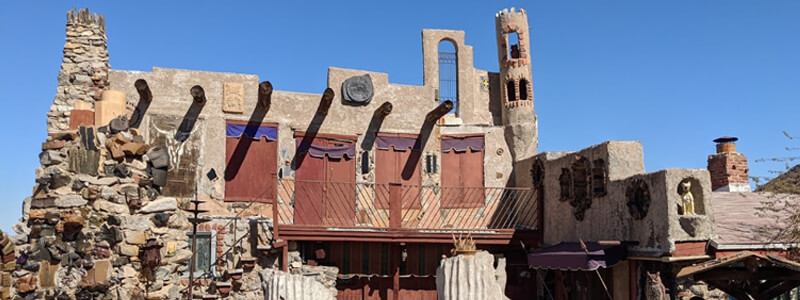Among unusual Arizona tourist sites, one of the best is the Mystery Castle just south of downtown Phoenix in the foothills of the South Mountain Preserve.
Constructed along the same lines as Frank Lloyd Wright’s Taliesin West, its masonry and stone structure goes beyond the architectural, offering visitors a look into one man’s tragic and romantic story: a long-lost husband and father; an abandoned wife and daughter; and a locked trapdoor hiding the secrets of two decades of silence.
A Tragic Story
In 1929 a former architecture student and tuberculosis patient named Boyce Luther Gulley left his home and family in Seattle for Phoenix, then a well-known haven for tuberculosis patients. Believing he had only a short time to live, he bought two 20-acre parcels of land on the fringes of the newly planned capital. Gulley planned to build a castle for his young daughter, with whom he had built sand castles by the sea.
Gulley didn’t die, however, and over the next fifteen years, he continued to work on his project, adding elements as his fanciful imagination dictated. By the time he died of cancer at 67 in 1945, the dwelling had grown to 8000 square feet and included eighteen rooms, thirteen fireplaces, and a number of parapets and patios. He never sent for his family.
Masonry Rock Walls, Kiln Rejects, and Cast-offs
Gulley’s application of the principles of organic architecture are enough to make his castle a worthwhile stopping point on any visit to Phoenix: concrete made of sand, water, and goat’s milk, and rocks gathered from the surrounding desert make up his primary building materials. But it is his early use of recycling coupled with an extravagant imagination that lends fantasy to his creation.
Pre-Tupperware fridge dishes bought for $7.50 a load finds a second life here as interior block glass windows; the spoked wheels of Gulley’s 1920s Stutz Bearcat become whimsical portals; brick “clinkers” or seconds with their melted surfaces and irregular shapes add color and texture to the frames of windows and fireplace mantels; old telephone poles become rafters and railroad ties serve as tracks for hide-away beds.
A Design Innovator
Such innovations reveal a mind both in sync with contemporary architectural movements and ahead of its time. The placement of his bedroom behind the main room fireplace to take advantage of radiated heat reveals an understanding of energy efficiency. And he may have been the first to conceive of detached kitchen cabinets, making him the creative force behind the “island kitchen.”
Practical concerns informed other innovations: not wanting to stoop to use the oven he separated it from the stove and made it eye level. And anticipating the future arrival of electricity—to replace the dangerous carbide gas then in use—he built in conduits for the lines throughout the property. It wasn’t until 1960, though, that electricity was finally brought to the castle, and by then his design was obsolete.
While the Castle exudes Arizona whimsy—from stuffed animals and life-size dummies to a collection of large stones painted to look like cats—the place boasts several museum-quality antiques. A bright orange Frank Lloyd sofa rubs elbows with bedroom furniture given to Gulley by Arizona’s first governor. A Suffragette coffee service and set of German china belonging to Gulley’s grandmother grace a dining room whose main feature is a table covered with a steer hide.
The Trap Door Reveals its Secrets
Upon his death, Gulley left the castle to his wife and daughter, stipulating that the trap-door not be opened for two years. By then Life Magazine had heard of the strange dwelling, and a reporter and photographer were present to record the event. In the dark recess, Gulley had left the deed to the property, two 500-dollar-bills, and some gold nuggets. He had also included a valentine his daughter had given him before his disappearance.
It was the article that Life published that popularized Gulley’s creation as the Mystery Castle. Soon after, visitors began arriving and formal tours were added in 1948. His daughter, Mary Lou Gulley, remained faithful to the memory of the father she had never known and lived there until her death in 2010.
How to Get to the Mystery Castle
The Castle is located in the foothills of the South Mountain Preserve south of downtown Phoenix. Take 7th Street to where it ends at Mineral Road and turn east. Tours run between October and May, Tuesday through Sunday from 11:00-4:00 PM.

